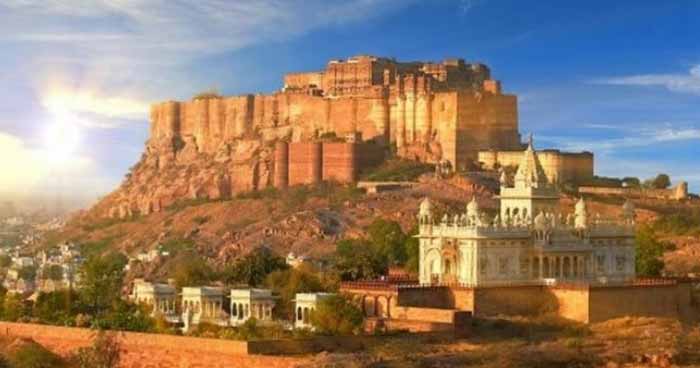UMAID BHAWAN PALACE: Also known as chittar palace, is a three-part monument that includes a heritage hotel, a museum, and the Maharaja’s royal residence. The Umaid Bhawan Palace is one of Jodhpur‘s most opulent hotels. It is an architectural marvel with all modern amenities and provides a royal experience. Here you will find marble squash courts, billiards rooms, a private museum, and much more. Royal artefacts and armour, old clocks, glassware, and other miniatures are on display at the museum.
MEHRANGARH FORT: This magnificent historical edifice, which serves as Jodhpur’s crowning glory, stands on top of a raised hillock that is 400 metres above the level of its surrounding terrains. It takes pride in being one of the largest forts in the world, with a sprawling expanse. This fort’s interesting history, well-preserved heritage, and stunning architecture make it the face of Jodhpur on a national and international scale. This gigantic structure, which is 500 yards long and features 120-foot high and 70-foot thick walls, was given the name Mehrangarh, which means ‘fort of the sun.’ Today, Maharaja Gaj Singh II, the current Rathore ruler, owns and preserves the fort. Its seven imposing entrances, including the famous Jai Pol (victory gate) and Fateh Pol, are the highlights. The architectural splendour of the royals can be seen in palaces such as Moti Mahal (Jodhpur Zenana), Sheesh Mahal, Takhat Vilas, and Phul Mahal. These palatial structures are adorned with mirror work, elaborate ornamentation, exquisite glass panels, alcoves, and impressive woodwork. A large portion of the Mehrangarh Fort has been turned into a heritage museum, which is considered one of the best in the country. The three-story Daulat Khana Gallery collects priceless Rathores artefacts. The museum store, which is the only one of its kind in the world, sells unique souvenirs to visitors.
JASWANT THADA: The Jaswant Thada is a work of art with its intricate carvings. It was constructed in 1899 by Maharaja Sardar Singh in memory of his father, Maharaja Jaswant Singh II, and is regarded as one of the most beautiful white marble cenotaphs in the world. The Taj Mahal of Marwar is the name given to this white marble wonder of Rajasthan. The magnificent structure is a perfect example of Rajputana architecture. Its impeccable design and architecture are evocative of bygone era fine craftsmanship. The main monument is designed in the style of a temple, with ornate domes and intricately carved statues. Beautiful portraits of the various rulers of Jodhpur can be found here. A monument to a peacock that flew into a funeral pyre can also be found at the complex. The cremation ground is surrounded by magnificently carved gazebos, an exquisite multi-tiered garden, and a small lake.
UMED GARDEN ZOO: Meet exotic birds from Africa and Australia at the UMED GARDEN ZOO. When you visit the Umed Garden Zoo’s Walk-in Aviary, you can watch ducks and rabbits interact. If you’re travelling with children, this is a must-see location. It promises a memorable and enjoyable experience, as well as numerous photo opportunities. When you visit the Umaid Garden Zoo in Jodhpur, your children can see wildlife in their natural habitat.
GOVERNMENT MUSEUM: See a one-of-a-kind exhibit of weaponry, textiles, miniature portraits, local crafts, and photographs of Jain Tirthankaras at the Government Museum (sages). Aside from that, there are many interesting objects to be found here. If you enjoy history and archaeology, a visit to this famous museum is a must.
MANDORE GARDEN: Mandore Garden is a heritage site on the outskirts of Jodhpur, in its namesake village. The garden remained as a reminder of the town’s glorious past after it was abandoned for the protection of the Mehrangarh Fort. The most notable feature of this garden is a high rock terrace. This landscaped garden is dotted with cenotaphs (dewals) of Jodhpur’s former rulers, which are unlike those found in other parts of Rajasthan. These four-story red sandstone cenotaphs with elaborately crafted columns and tall spires resemble Hindu temples. The Maharaja Ajit Singh memorial and others constructed for the Maharani atop a hill are notable among these dewals. Close to these cenotaphs is the hall of heroes, which is devoted to heroic Rajput fighters and Hindu deities. This hall is adorned with colourful rock statues and images of these heroes and Gods. In Mandore Garden, the ‘Shrine of the Three Hundred Million Gods’ is a must-see attraction. Here are vibrant illustrations of Hindu gods that demonstrate the brilliance of artists at the time. Visitors can see the old palace and ruins of Mandore by climbing a nearby hill.
PHALODI FORT: The Phalodi Fort is a historical site in Jodhpur’s small town of Phalodi. Rao Hammir Narawat, the grandson of Rao Suja Maharaja of Jodhpur, built this imposing structure in 1488. The fort showcases the fine work of Marwar artists from a bygone era.
RAO JODHA JI STATUE: The Rao Jodha Ji Statue is located on a small hilltop near Jaswant Thada (near the Mehrangarh Fort). It was constructed in memory of Rao Jodha Ji, the founder of the lovely city of Jodhpur. Rao Jodha Ji is depicted on a horse, pointing towards the fort, and is surrounded by iron grills. On the 554th Jodhpur Foundation Day, May 12, 2012, this magnificent statue was unveiled.

